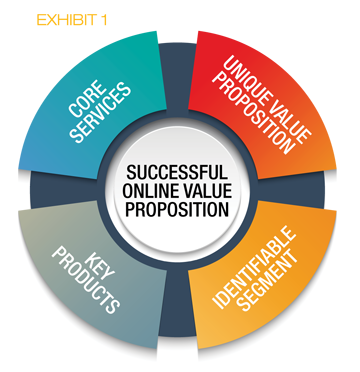Carving a winning online value position

By Scott Benfield
One cannot read industrial distributor news outlets without encountering endless articles prognosticating on e-commerce and the effect on full-service distribution. Pundits, enlightened operators and researchers glean common themes for distributors for e-commerce, including:
1) The sector has been slow to engage technology, as 60 percent of distributors sell less than 5 percent online and 20 percent of distributors consummate 80 percent of online sales.
2) Manufacturers are increasingly selling direct to customers and bypassing distribution. Our research finds that 30 percent of sales come from online entities such as Amazon, eBay and other online specialty distributors.
3) Non-traditional distributors are entering into the online space competing for MRO/Industrial orders and attracting investors; read Interline Brands purchased by The Home Depot or Maintenance Supply Headquarters purchased by Lowe’s. The expressed intent is for the parent firms to secure more sales from the professional contractor and maintenance mechanic working in industry, civic institutions or housing.
The lesson from leading MRO/Institutional online sites including Home Depot’s Interline Brands and Grainger is that successful e-commerce follows a careful vetting of a value proposition supported with the latest online technology. Home Depot has, at last count, five branded sites and Grainger, with the addition of Gamut.com, has five sites if one includes the two Zoro Tool sites (North America and Germany). The gist of this article is to give an overview of what it will take for distributors to compete online with those that are winning today.
First Things First
To compete online, distributors need a full suite of software including a modern transaction platform, Product Information Management (PIM), faceted search, punch-out and quotation management. Our 2016 research finds that only 15 percent of distribution firms have this full suite of software. With this software suite, distributors outsold their competition online by a factor of three times.
Distributors will also need to consider their investment in product content. Many are satisfied to let outside content development services gather product content and develop it for a fee. These services, while valuable, don’t offer the ability to syndicate content for different markets, different applications, and different channels. This is, typically, offered by a PIM, which manages the onboarding of content as well as its delivery for marketing purposes. As online sales become more common, we will find that more distributors will complete their software platform as prices fall. What is not known is if prices will fall fast enough to allow mid-market and smaller firms to move online before it is too late.
Generating the Online Model
Once the software platform is built out, the distribution firm can begin to research and develop online value propositions that appeal to a growing league of internet buyers. Distributors often market their full-service value proposition online when starting out and this is, almost always, a bad idea. The problem is that the full-service platform is a sales-driven entity made for a time when the personal sales call influenced and used “push” marketing to get the customer to purchase. This full-service model, often, does not translate well online. Why? First, bearing the costs of outside and inside sales personnel and multiple branches is expensive. There are simply fewer of these folks needed in an online world. Secondly, the online model is developed to help the customer self-serve. To do this well, sites have substantial search software that includes product strings and product nomenclatures including industry jargon. Product content has to be consistent and of the highest quality or the online buyer can’t trust the site.
Lastly, and the subject of this piece, the full-service model often has no online value proposition the buyer can identify with. The full-service model has been developed over years by sellers who are compensated on margin dollars. They, literally, will sell any type of account that pays. As the market matured, sellers added services to key customers and expanded the product portfolio. The operating platform turned complex, and inefficient margins on commodities and small customers had to be raised, often to the stratosphere, to cover the complexity of the firm.
Most mid-sized to large traditional brick and mortar distributors’ strategy is driven by geography and sellers’ territory holdings. There is no precise value position to the full-service brick and mortar model, as location and sales commissions are, mostly, internal constraints and don’t focus outward to any particular customer segment. The upshot of putting the full-service model online, without a good, focused value position, is that many distributors invest millions of dollars in online software to fail. We call this the Digital Washout, and some two-thirds of online failures are due to poor marketing strategy of putting the full-service model online.
 The Online Value Stream Model
The Online Value Stream Model
In Exhibit I, we’ve illustrated the four parts of a successful online value stream for distributors. While seemingly common sense, the reader should remember that successful online strategies, using unique value propositions, are less than 5 percent of all distribution firms. Common marketing sense is not all that common or easy to replicate.
The segment is the building block of the online value stream. A segment is a group of common customers with common needs. Generally, segments are customers with common applications. For instance, steel manufacturing is different from food manufacturing which is different from infrastructure supplies for colleges and universities. There is a good chance, however, that these industries, across geographies, have common applications.
To help with segmentation, distributors should use NAICS codes and information from public and private sources to understand if the segment is sizable enough in revenues to be served. Additionally, the segment should be researched to understand if there is online competition that is entrenched.
A viable segment would also have common products and services. For initial research, we recommend reviewing key products and core services. These are the building blocks to a workable online strategy and, without them, there is no reason for the customer to continually visit the distributor’s site. The review of the segment for common products and services should include valid market research. We recommend research from online sources, personal interviews and data mining. A combination of these research methods helps refine exactly which products and services the segment desires.
Finally, the most important part of a successful online value proposition is the unique value of the site. We term this part of the exercise more art than science and an example may give insight. The unique value proposition is often an uncovered need or unique bundling of needs that draws the segment buyer in. The value proposition, to be effective, is learned quickly by the prospective customer in the first pages of the site.
A good example is AmeriPride Linen and Uniform Services at www.ameripride.com. The uniform supplier’s home page is unique in several ways. First, it quickly moves beyond the provision of work uniforms to the management of uniforms and variations of uniform service including the company’s C3 service platform and C3 Mobile Technology programs. Additionally, the site is segmented into six separate markets with common applications and unique service needs. While there are numerous uniform suppliers, we like AmeriPride’s unique value proposition in that they are selling unique uniform management services to unique segments. And this value proposition meets the four criteria of a successful online value proposition including identifiable segments, key products, core services and a unique value proposition.
Distributor Success Online
As the B2B buyer moves online, the durable goods distributor will need to engage a competitive software suite to compete. Today, the software is expensive and whether it is purchased outright or rented (SaaS), the cost of programs, integration and specialists often runs well into seven figures.
Once the platform is completed, the distributor should carefully review market segments where they are providing or can provide a unique value proposition. Too many distributors spend copious sums on software to get online but fail as they attempt to put the old-style, brick and mortar/sales driven model online.
The most successful online platforms serve identifiable segments with key products, core services and unique value propositions. They are focused, efficient and cost-competitive business models that, so far, easily slice through the full-service competition to the online customer.
 Scott Benfield is a consultant for manufacturers and distributors in B2B channels. He is the author of six books and numerous research studies on changes in B2B relationships and channel structure. His firm’s work can be seen at www.benfieldconsulting.com and Scott can be reached at Scott@BenfieldConsulting.com.
Scott Benfield is a consultant for manufacturers and distributors in B2B channels. He is the author of six books and numerous research studies on changes in B2B relationships and channel structure. His firm’s work can be seen at www.benfieldconsulting.com and Scott can be reached at Scott@BenfieldConsulting.com.
This article originally appeared in the July/August 2017 issue of Industrial Supply magazine. Copyright 2017, Direct Business Media.













